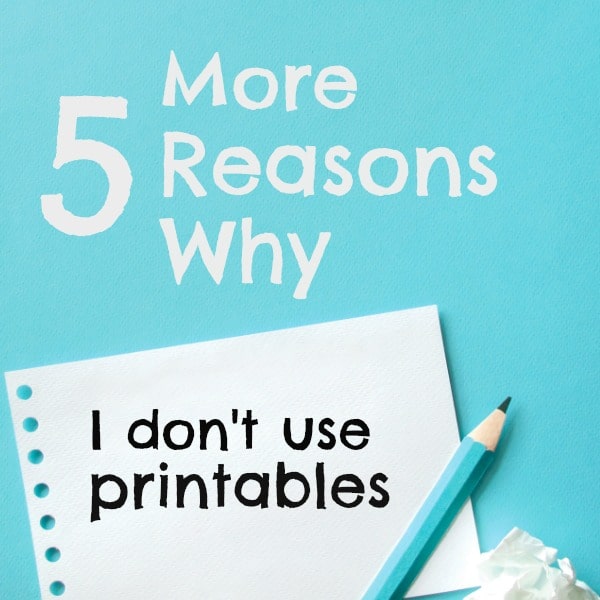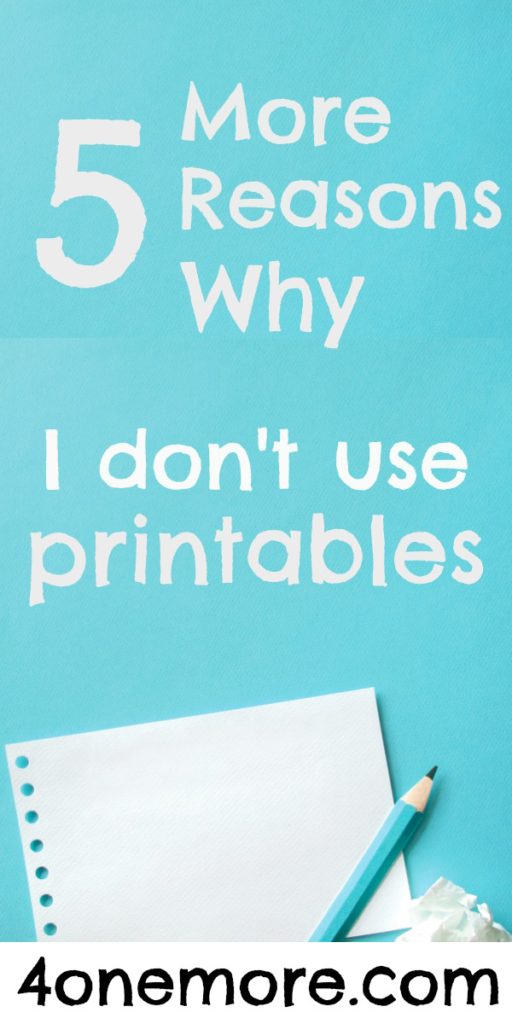You already know that I don’t use printables (and you shouldn’t either). But printables are everywhere! Have you searched “homeschool printables” or “homeschool worksheets” lately on Pinterest? You could spend the next year saving, printing, laminating, and organizing your beautiful printables. But is using lots of printables in your homeschool the best way to learn or assess learning? No, I don’t think so. Here are 5 more reasons why I don’t use printables.

This post contains affiliate links for your convenience. I will receive a commission if you purchase from these links. Thank you.
5 More Reasons Why I Don’t Use Printables
{Friendly Disclaimer: If you mainly use textbooks and worksheets in your homeschool and it totally works for you, then carry on! You do you. This post is for the moms who are stressed out with printables but don’t know what else to use.}
1. A pile of worksheets does not equal learning
Just having a pile of worksheets does not mean that your child understands a concept or topic. A better question is this: can they demonstrate a skill or explain in their own words?
If you can’t explain it simply, you don’t understand it well enough – Einstein
Consider this scenario:
You decide to teach your child all about music notation and reading notes on a staff. You find the cutest worksheets about note reading. After filling out an entire pile of printables, consider if your child can actually use the knowledge she just learned. How would you best assess this? A test? Another pile of printables? No, can she play a simple song with a melody flute or on a piano? You can learn about a topic till the cows come home, but filling out a pile of worksheets never equals actual learning. Has she really learned how to read music or just completed a pile of cute printables?
2. Mostly requires low-level thinking
Thinking skills are not created equal. There are low level skills (like fact recall) and higher order thinking skills (such as analysis and synthesis).
How does this look on a daily basis in your homeschool?
Printables that require low level thinking skills might ask:
- Match the state to the capital
- Highlight the verb in the sentence
- Circle the animals that are mammals
- Select the correct answer from multiple choice options
- Search for spelling words in a word find
Activities that require higher level thinking skills might include:
- Write the state and capital on a map
- Create a sentence in the present tense with subject-verb agreement
- Group animals together based on similarities in body structure and explain your grouping
- Summarize the science lesson in your own words
- Generalize the spelling rule and give example words that fit this structure
Do you see the difference? Google “Bloom’s Taxonomy” and you’ll find dozens of graphs that illustrate the different levels of thinking.
Does this mean you can never use a worksheet and never expect memorization of data? No, of course not. But if that’s all you’re requiring in your homeschool, your kids might not be challenged to a higher level.
3. Kids feel like they’re in school prison
Symptoms of this can be:
- tears
- boredom
- resistance
Printables can seem pointless to kids. It feels like busy work. And they really are perceptive to feel this way. Using loads of worksheets as your educational philosophy can lead kids to think: what’s the point?
But on the other hand, when you pull kids into the higher thinking skills and let them enjoy learning again, you will have engaged and curious learners who are also taking responsibility for their own growth.
4. Adds clutter to schooling
Homeschooling provides the most effective and efficient method: the one-on-one tutor approach. This is the dream of classroom teachers everywhere who have to teach a whole class of over twenty kids at a time. Individualized attention? That’s an unrealistic dream in a traditional classroom.
By simply discussing the topic at hand, using living books and hands-on exploration, you have an uncluttered learning experience that is also efficient. You can meet your kids right where they’re at and build on their level of mastery.
Why have them fill out mindless worksheets about common and proper nouns if they are solid in their understanding of that topic and ready to move on? Let’s build upward from that foundation, not create work to fill time.
When you dump piles of printables on your kids on a daily basis, school becomes cluttered for no good reason. Remember, filling out printables does not equal learning.
5. Only measures one type of learning
We discussed this a bit in the previous point about levels of thinking skills. Printables tend to be tolerated mostly by one type of kid: the kind that likes to fill out worksheets.
The kinesthetic learners (think: elementary aged boys) would rather participate in a hands-on activity. The auditory learner wants to be able to talk through the lesson, not simply fill in blanks. The visual learner might enjoy creating a colorful poster categorizing the details of the subject at hand.
What does homeschool look like if you try to include multiple learning styles?
- oral narration
- notebooking
- play acting (history)
- art
- interviewing
- creating a comic strip summarizing the plot line of the book you just read
- participate in a science experiment instead of simply reading about it
- watch a documentary
- create a diorama
- discuss cause and effect in science or history or literature
- create graphic organizers that explain that cause and effect
- role play
- story boards
- sketch & label
- teach back to younger sibling
- sketch maps
- this is just the tip of the iceberg! What ideas do you have?
I created this super practical freebie for you to download when you sign up for my newsletter. You can grab these Repetition Punch Cards.
[thrive_leads id=’7627′]
How do you use a Repetition Punch Card?
Print (optional: laminate) the page below then cut out the cards. Give one card to your child with instructions to hole punch or cross off one circle for every completed repetition. You can also use these cards to keep track of days that a skill is practiced. When your child has completed his card, he can turn it in to you for a predetermined prize – movie night, donut date, or extra time on Minecraft?
The possibilities are endless with these fun punch cards. Use them for:
- math facts
- books read
- make your bed
- get school done by noon
- motivation cards
- practice cards
- practice instrument
- help around the house
- clean up your room
- daily reading time
- completing work with a good attitude
You can find these punch cards anytime in my FREE members-only resource library or sign up below.
[thrive_leads id=’7627′]
